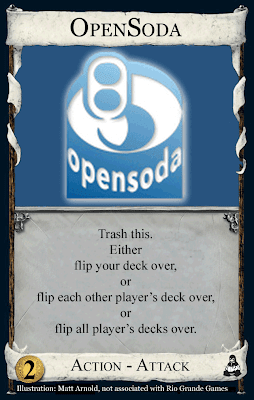Review of Tokaido
Mar. 31st, 2013 03:28 pmThe French illustrator Naiade is my favorite game artist. FunForge has started cranking out games that immediately grab my attention with his art. So naturally, Tokaido caught my eye.
This is a game that moves quickly, and only takes about forty-five minutes.
It has a very light and non-violent tone. This is a game of vacation planning. You attempt to have as good a trip as possible along the East Sea Road ("Tōkaidō") in medieval Japan. Eat sumptuous meals, view gorgeous panoramas, buy beautiful souvenirs, and meet interesting people. Each stop along the track gives you one of these in the form of a card, which you keep face-up in front of you. Mostly, you are trying to collect combinations of cards.
The gameplay is simple: if your pawn is the farthest behind on the road, it's your turn. Move it forward to one of the tourist attractions, and take a corresponding card. Whoever is now in the back of the line-- even if that is still you-- takes a turn.
The attractions can get too crowded. Each attraction can only accommodate one or two guests at a time. In order to make sure nobody crowds you out of an attraction that is important to completing a set of cards that you need, sometimes you should pass an empty attraction and skip ahead. You can usually have exactly what you want, if you are willing to sacrifice.
The first question you will hear during an explanation of Tokaido is "So, as my first move of the game, I can go all the way to the end of the road?" There are inns at the conclusion of each of the four legs of your journey. You are required to stop at each inn and wait for all the other players to catch up. Besides, you wouldn't want your first move to go as far as the game rules permit, because your first leg of the journey would score you only six points (your meal at the inn), while your opponents would soak up all the luxuries you skipped. Probably the most subtle and crucial decision in the game is when to skip an attraction.
Be advised, each player starts with a different character who confers a unique advantage. The tacticians among you may wonder if your choice of character at the beginning of the game has an undue influence on who wins. This is also a game in which you are unlikely to win if you focus on yourself. Observe which sets of cards your fellow travelers are attempting to build.
The production values make the equipment a joy to use, the play is suitable for children and adults, and it's short enough that I found myself wishing the East Sea Road was a little bit longer.
This is a game that moves quickly, and only takes about forty-five minutes.
It has a very light and non-violent tone. This is a game of vacation planning. You attempt to have as good a trip as possible along the East Sea Road ("Tōkaidō") in medieval Japan. Eat sumptuous meals, view gorgeous panoramas, buy beautiful souvenirs, and meet interesting people. Each stop along the track gives you one of these in the form of a card, which you keep face-up in front of you. Mostly, you are trying to collect combinations of cards.
The gameplay is simple: if your pawn is the farthest behind on the road, it's your turn. Move it forward to one of the tourist attractions, and take a corresponding card. Whoever is now in the back of the line-- even if that is still you-- takes a turn.
The attractions can get too crowded. Each attraction can only accommodate one or two guests at a time. In order to make sure nobody crowds you out of an attraction that is important to completing a set of cards that you need, sometimes you should pass an empty attraction and skip ahead. You can usually have exactly what you want, if you are willing to sacrifice.
The first question you will hear during an explanation of Tokaido is "So, as my first move of the game, I can go all the way to the end of the road?" There are inns at the conclusion of each of the four legs of your journey. You are required to stop at each inn and wait for all the other players to catch up. Besides, you wouldn't want your first move to go as far as the game rules permit, because your first leg of the journey would score you only six points (your meal at the inn), while your opponents would soak up all the luxuries you skipped. Probably the most subtle and crucial decision in the game is when to skip an attraction.
Be advised, each player starts with a different character who confers a unique advantage. The tacticians among you may wonder if your choice of character at the beginning of the game has an undue influence on who wins. This is also a game in which you are unlikely to win if you focus on yourself. Observe which sets of cards your fellow travelers are attempting to build.
The production values make the equipment a joy to use, the play is suitable for children and adults, and it's short enough that I found myself wishing the East Sea Road was a little bit longer.























